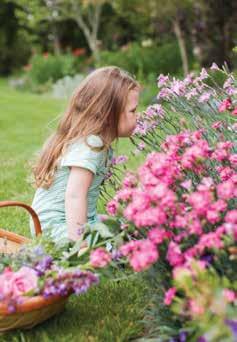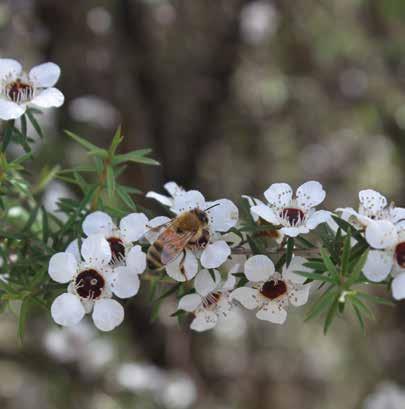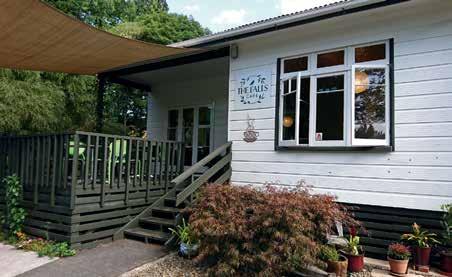
4 minute read
Gardening
Bee Friendly
WORDS LYNDA HALLINAN
Imagine a world without bees; according to some environmental pundits, we’d all be dead within a decade because bees pollinate more than half of our food crops.
That is true, to a point. Bees are certainly responsible for pollinating the majority of our most delicious food crops, but traditional staples, such as rice and corn, rely on gusty weather rather than worker bees. While we might have to kiss goodbye to smashed avocado on five-grain toast, there'd be no shortage of bread as wheat, oats, barley and rye are all wind-pollinated.

In our gardens, we could still grow lentils and most legumes, as well as leafy green vegetables including spinach, silverbeet and all brassicas (because we eat them before they flower, though saving enough seeds could be compromised). However, our orchards would bear little if any fruit — and even soft fruits that don't rely on bees to fertilise their flowers, such as strawberries, wouldn't taste as sweet.
An intriguing study by agroecology researchers at the University of Göttingen in Germany found that strawberries pollinated by bees grew redder, tasted sweeter (the ideal sugar-acid ratio), were more uniformly shaped and had a longer shelf life than strawberries grown behind an insect barrier without visitation rights for bees.
Why? Because strawberries are made up of as many as 200 tiny ovaries stuck together, and when bees pollinate their flowers, those ovaries go into overdrive, producing natural hormones that ripen the flesh around their seeds.
What's more, strawberries taste even better when pollinated by a tag-team of wild bees (who work the base of the flower) and honeybees (who tap and gap it from the top of the flower).
Even self-fertile crops, such as coffee, benefit from bee activity, producing greater yields of higher quality beans. So, in a world without bees, you could still order your daily espresso, but chances are you couldn't afford it — and if you're plant-based, you'd have to forego any frothy almond milk.
As I write this, on a sunny day in the first week of August, the almond grove on the bank below my house is in full bloom. Almonds (Prunus dulcis) are the first to break bud after winter, luring my neighbour's million-plus bees out of their hives to work their magic on those blossoms, one by one.
If I didn't grow my own almonds, I couldn't eat them without feeling guilty. Every year, more than two-thirds of America's commercial honeybee hives are trucked to California, where 80 per cent of the world's almonds are grown, to pollinate this pesticideheavy crop. In the 2018–19 season, more than 50 billion bees lost their lives while working in those trees.
There are many theories as to why, from chemical contamination to pest and disease exposure (it's like a bee bordello) and worker exploitation: because almonds blossom early, when bees are traditionally taking a winter rest, they simply run out of resources to keep going. But I have my own theory. I reckon those billions of bees are dying from dietary boredom. Just imagine being served the same meal all day, every day, until you die.
Just as the manuka honey boom sees thousands of Kiwi hives trucked into bush backblocks at a time when bee fodder is scarce, the almond industry is a monoculture on an unprecedented scale, serving up the dullest of single-flavour fare. Bees deserve better, and we can all play our part in delivering them a more biodiverse diet, rich in pollen and nectar from as many sources as possible.
It doesn't matter if your garden is as large as mine or is confined to a collection of pots on a patio. For every edible crop you plant for yourself, sow another for the bees. Simple bee-friendly ideas include scattering wildflowers on street berms or in empty vege beds, slipping punnets of flower seedlings between the rows of veges in your potager, planting herbal leys around lifestyle block orchards and selecting bee fodder trees for farm shelterbelts. And never, ever spray anything in flower.
As the Indian Hindu sage Ramakrishna once said, "When the flower blooms, the bees come uninvited."
Lynda Hallinan
Waikato born-and-raised gardening journalist Lynda Hallinan lives a mostly self-sufficient life at Foggydale Farm in the Hunua Ranges, where she grows enough food to satisfy her family, free-range chooks, kunekune pig and thieving pukekos. She has an expansive organic vegetable garden and orchards and is a mad-keen pickler and preserver.

Seasonal checklist
Weed, wait two weeks, then repeat. When clearing vege beds for planting, disturbing the soil always results in a rash of spring weed growth. Use a push hoe.
Direct-sow beetroot, broad beans, carrots, Florence fennel, radishes, peas, parsnips, swedes and quickcropping white turnips.
Don't rush to transplant tomatoes, zucchini, peppers, cucumbers and other heat lovers. Wait until Labour Weekend when the weather is more settled.
Plant potatoes — waxy earlies and starchy maincroppers — as soon as the risk of late frosts has passed. Get them in early, and out early to avoid issues with the potato-tomato psyllid in late summer.
Located in BEAUTIFUL McLaren Falls Park Tranquility just outside of the city.


Open Wednesday to Friday 9am to 3pm saturday & sunday 9am to 4pm McLaren Falls Park, 140 McLaren Falls Road, Tauranga 07 5434976 | harriet.fallscafe@gmail.com










